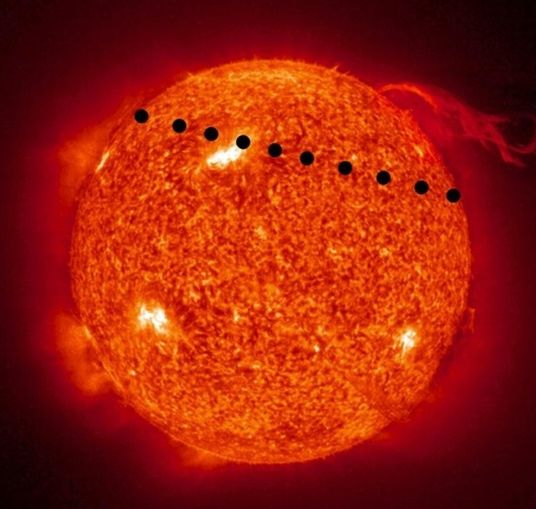 日志正文
|
||
  金星凌日 2004年六月见证了金星在122年以来第一次穿越过太阳的表面,此现象称之为“凌日”。凌日现象帮助塑造了我们对整个宇宙的认知,正如Heather Cooper和Nigel Henbest所解释的那样
A 在2004年六月8日, 有超过一半的世界人口享受了一场稀有天文学事件(更好的说法是“天象”)的视觉盛宴。在六个多小时的时间里,金星稳定地逐寸通过太阳的表面。这一金星的“凌日”是自1882年12月6日以来的第一次。当时,美国天文学家Simon Newcomb教授带领一支团队到南非去观察这一天象。他们驻扎在一所女子学校中,在那里——据说——三位女教师共同努力的结果比专业人员所进行到的观察还要准确。(这个句子中进行比较的两方是:combined forces … outperformed the professionals. out加在perform前面合成了一个具有两者意思的词,也就是前者combined forces的成绩超过了后者;with the accuracy of their observations是后置了修饰schoolmistresses的,女教师用她们观测的正确性outperform了专业人员)
B 几个世纪以来,金星凌日的现象始终在同时吸引着探险者和天文学家们去到世界的四面八方。而你可以将这一切都归因于杰出的大学者埃德蒙哈雷(Edmond Halley)。在1677年十一月,Halley观察到了太阳系最内侧的行星,水星,的凌日现象,地点是南太平洋上的一个孤岛St Helena。他意识到,从不同的纬度上看,行星穿过日轮的景象会是不一样的。通过从两个距离遥远的不同地点对凌日的时间进行记录,天文学家的团队就可以计算出视差角——即由于观察者位置的不同而导致一个天体的位置在显示上的明显差异。计算这一角度就能使得天文学家丈量出那个最终的目标:地球到太阳的距离。这一距离被称为“天文单位”或曰AU。
C Halley知道AU是所有天文测算中最基础的单位之一。开普勒(Johannes Kepler),在17世纪早期,就指出了行星到太阳的距离决定了它们的轨道速度,而轨道速度是很好测算的。但是还不曾有人找到一个方法来计算地球与其它行星之间的精确距离。人们的目标是要测量出AU;接下来,知道了所有其它绕太阳运转的行星的轨道速度,太阳系的规模也就水到渠成地显现在人们面前了。但是,Halley意识到,水星是如此的遥远,它的视差角会是极其难以确定的。因为金星距离地球更近,它的视差角会大些,因此Halley认定通过利用金星将有可能将地球到太阳的距离测算到500分之一的精确度。但是有这么一个问题:金星的凌日,不同于水星的那些,是稀少的,每一百年左右才会伴发两次,这两次之间的彼此间隔时间大约是八年。不过,他准确地预言了金星将会在1761年和1769年穿过太阳的表面——尽管他自己并没有活着看到其中的任何一次。
D 受到Halley所提出的关于测定太阳系规模的这一方法的启发,英国和法国的天文学家团队出发去到了世界各地进行探索,这些地方从印度到西伯利亚不一而足。但是英国和法国当时正在交战,这可不利于事态发展。最值得同情的人是法国天文学家让蒂(Guillaume Le Gentil)。首先阻挠他的是英国人当时正在围攻他的观测地点,位于印度的本地治里(Pondicherry)。在坐着一艘法国战舰穿越印度洋逃离的时候,Le Gentil看到了一场无比清晰的凌日——但是船的晃动颠簸杜绝了任何进行准确观测的尝试。他没有为之气馁,而是留在了赤道以南,在去往菲律宾观测下一次凌日现象之前先让自己忙碌于研究毛里求斯(Mauritius)和马达加斯加(Madagascar)诸岛。讽刺的是,在奔波了将近50,000公里之后,他的视野在最后一刻被乌云遮蔽了,一次非常令人失望的经历。
E 虽然早期的凌日时间测算在工具所允许的范围内已经尽可能精确了,但这些测量还是受到了“黑滴”现象的干扰。当金星开始穿越太阳的日轮时,它看起来是边界模糊不清的而不是圆形——这就使得确认时间变得困难。这种现象是由于光的衍射。第二个问题在于金星刚刚超出日轮之外的时候看起来会显示出一圈光晕。虽然这向天文学家们显示出金星外围包裹着一层厚厚的气体而折射了周围的太阳光,但这两种效应都使得获取准确的时间测量变成了不可能的事。
F 但天文学家们还是竭尽全力地分析了这些观测金星凌日现象的探索结果。恩克(Johann Franz Encke),柏林天文台台长,最终在所有这些视差测量的基础上确认了AU的数值:153,340,000公里。这在当时已经是颇为准确的了,相当接近于今天的测定值149,597,870公里,而后者是使用雷达计算出的数值,它的准确性超越了凌日观测和其它所有的方法。AU是宇宙丈量的准绳,也是我们今天测算宇宙规模的基础。视差原理还可以进一步扩展到用于测量其它恒星的距离。如果我们在一月份观察一颗恒星——在地球位于其轨道上的某个点位——六个月后再看起来它就好像位于一个不同的位置。知道了地球轨道的宽度,视角的差异就令天文学家得以计算出它的距离。
G 2004年六月的金星凌日因此更多地只是一场天文奇景而非一项具有重要科学研究价值的事件。但是这样的凌日现象逐步铺就了道路,成就了也许会被证明是宇宙中最为重要的突破之一——侦测绕其它恒星运行的与地球尺寸相似的行星们。
Venus in transit June 2004 saw the first passage, known as a ‘transit’, of the planet Venus across the face of the Sun in 122 years. Transits have helped shape our view of the whole Universe, as Heather Cooper and Nigel Henbest explain
A On 8 June 2004, more than half the population of the world were treated to a rare astronomical event. For over six hours, the planet Venus steadily inched its way over the surface of the Sun. This ‘transit’ of Venus was the first since 6 December 1882. On that occasion, the American astronomer Professor Simon Newcomb led a party to South Africa to observe the event. They were based at a girls’ school, where – it is alleged – the combined forces of three schoolmistresses outperformed the professionals with the accuracy of their observations.
B For centuries, transits of Venus have drawn explorers and astronomers alike to the four corners of the globe. And you can put it all down to the extraordinary polymath Edmond Halley. In November 1677, Halley observed a transit of the innermost planet, Mercury, from the desolate island of St Helena in the South Pacific. He realised that, from different latitudes, the passage of the planet across the Sun’s disc would appear to differ. By timing the transit from two widely-separated locations, teams of astronomers could calculate the parallax angle – the apparent difference in position of an astronomical body due to a difference in the observer’s position. Calculating this angle would allow astronomers to measure what was then the ultimate goal: the distance of the Earth from the Sun. This distance is known as the ‘astronomical unit’ or AU.
C Halley was aware that the AU was one of the most fundamental of all astronomical measurements. Johannes Kepler, in the early 17th century, had shown that the distances of the planets from the Sun governed their orbital speeds, which were easily measurable. But no-one had found a way to calculate accurate distances to the planets from the Earth. The goal was to measure the AU; then, knowing the orbital speeds of all the other planets round the Sun, the scale of the Solar System would fall into place. However, Halley realised that Mercury was so far away that its parallax angle would be very difficult to determine. As Venus was closer to the Earth, its parallax angle would be larger, and Halley worked out that by using Venus it would be possible to measure the Sun’s distance to 1 part in 500. But there was a problem: transits of Venus, unlike those of Mercury, are rare, occurring in pairs roughly eight years apart every hundred or so years. Nevertheless, he accurately predicted that Venus would cross the face of the Sun in both 1761 and 1769 – though he didn’t survive to see either.
D Inspired by Halley’s suggestion of a way to pin down the scale of the Solar System, teams of British and French astronomers set out on expeditions to places as diverse as India and Siberia. But things weren’t helped by Britain and France being at war. The person who deserves most sympathy is the French astronomer Guillaume Le Gentil. He was thwarted by the fact that the British were besieging his observation site at Pondicherry in India. Fleeing on a French warship crossing the Indian Ocean, Le Gentil saw a wonderful transit – but the ship’s pitching and rolling ruled out any attempt at making accurate observations. Undaunted, he remained south of the equator, keeping himself busy by studying the islands of Mauritius and Madagascar before setting off to observe the next transit in the Philippines. Ironically after travelling nearly 50,000 kilometres, his view was clouded out at the last moment, a very dispiriting experience.
E While the early transit timings were as precise as instruments would allow, the measurements were dogged by the ‘black drop’ effect. When Venus begins to cross the Sun’s disc, it looks smeared not circular – which makes it difficult to establish timings. This is due to diffraction of light. The second problem is that Venus exhibits a halo of light when it is seen just outside the Sun’s disc. While this showed astronomers that Venus was surrounded by a thick layer of gases refracting sunlight around it, both effects made it impossible to obtain accurate timings.
F But astronomers laboured hard to analyse the results of these expeditions to observe Venus transits. Johann Franz Encke, Director of the Berlin Observatory, finally determined a value for the AU based on all these parallax measurements: 153,340,000 km. Reasonably accurate for the time, that is quite close to today’s value of 149,597,870 km, determined by radar, which has now superseded transits and all other methods in accuracy. The AU is a cosmic measuring rod, and the basis of how we scale the Universe today. The parallax principle can be extended to measure the distances to the stars. If we look at a star in January – when Earth is at one point in its orbit – it will seem to be in a different position from where it appears six months later. Knowing the width of Earth’s orbit, the parallax shift lets astronomers calculate the distance.
G June 2004’s transit of Venus was thus more of an astronomical spectacle than a scientifically important event. But such transits have paved the way for what might prove to be one of the most vital breakthroughs in the cosmos – detecting Earth-sized planets orbiting other stars.
阅读(?)评论(0)
上一篇: C9T1P3:乌龟的历史
下一篇:C4T2P2:澳大利亚的替代性医疗
|
||









评论 想第一时间抢沙发么?
想第一时间抢沙发么?